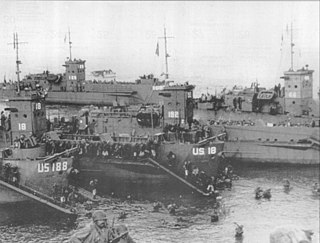USS Accentor was an LCI(L)-351-class landing craft infantry in the service of the United States Navy, named after the accentor bird.

USS Begor (DE-711/APD-127) was a Crosley-class high speed transport of the United States Navy.

The Shinyo were Japanese suicide motorboats developed during World War II. They were part of the wider Japanese Special Attack Units program.

The Landing Craft Infantry (LCI) were several classes of landing craft used by the Allies to land large numbers of infantry directly onto beaches during World War II. They were developed in response to a British request for seagoing amphibious assault ships capable of carrying and landing substantially more troops than their smaller assault landing craft (LCA). The result was a small steel ship that could land 200 men, traveling from rear bases on its own bottom at a speed of up to 15 knots.
USS LCI(L)-760 was an LCI-351-class Landing Craft Infantry (Large), laid down and launched on dates unknown. Commissioned on 26 May 1944 as USS LCI(L)-760, reclassified LCI(G)-760 (Gunboat) on 31 December 1944, and again reclassified as LCI(M)-760 (Mortar) on 30 April 1945.

USS Pandemus (ARL-18) was one of 39 Achelous-class landing craft repair ships built for the United States Navy during World War II and was in commission from 1945 to 1946 and from 1951 to 1968. Named for Pandemus, she has been the only U.S. Navy vessel to bear the name.

USS Owl (AMCU-35) was a LCI(L)-351-class large landing craft of the United States Navy, later converted to an AMCU-7-class coastal minesweeper.
USS Oriole (AMCU-33) was a LCI(L)-351-class large landing craft of the United States Navy, later converted to an AMCU-7-class coastal minesweeper.

USS LST-19 was a United States Navy LST-1-class tank landing ship used exclusively in the Asiatic-Pacific Theater during World War II and manned by a United States Coast Guard crew. Like many of her class, she was not named and is properly referred to by her hull designation.

The Brown Shipbuilding Company was founded in Houston, Texas, in 1942 as a subsidiary of Brown and Root by brothers Herman and George R. Brown to build ships for the U.S. Navy during World War II. Brown Shipbuilding Company ranked 68th among United States corporations in the value of World War II military production contracts.
USS LCI(L)-449 was an LCI(L)-351-class landing craft infantry built for the United States Navy during World War II. Like most ships of her class, she was not named and was known only by her designation.

USS LCI(L)-189 was an amphibious assault ship commissioned in 1943 by the United States Navy and assigned to the Mediterranean theater during World War II. As part of Operation Husky, LCI(L)-189 participated in the allied landings in Sicily from 9–15 July 1943. From 9–21 September 1943 LCI(L)-189 took part in the Salerno landings during Operation Avalanche.

USS LCI(L)-19 was an amphibious assault ship commissioned in 1943 by the United States Navy and assigned to the Mediterranean theater during World War II. As part of Operation Husky, LCI(L)-19 participated in the allied landings in Sicily from 9–15 July 1943. From 9–21 September 1943 LCI(L)-19 took part in the Salerno landings during Operation Avalanche.
USS LCI(L)222 was a United States Navy ship classified as a Landing Craft Infantry Large. She was assigned to the Asiatic-Pacific Theater during World War II.

USS LCI(L)-90 was an amphibious assault ship manned by a United States Coast Guard crew. She was commissioned in 1943 and was used to land troops in the landings on French North Africa, Sicily and Anzio in 1943, and at Omaha Beach during the Invasion of Normandy in 1944. She participated in the invasion of Okinawa, where she was attacked by a Japanese kamikaze fighter. Her two commanding officers were both Lieutenant junior grade, of the Coast Guard. William Trump a seaman who volunteered to go ashore before the troops, at Omaha Beach, and lay out a cable through a safe path to shore, was awarded a Silver Star. According to a soldier who landed from LCI-90 during the Invasion of Normandy, the vessel's doors were damaged by enemy fire. During the Invasion of Okinawa LCI-90 was damaged by a kamikaze, after she had landed her soldiers, and one seaman was killed.

Project Hula was a program during World War II in which the United States transferred naval vessels to the Soviet Union in anticipation of the Soviets eventually joining the war against Japan, specifically in preparation for planned Soviet invasions of southern Sakhalin and the Kuril Islands. Based at Cold Bay in the Territory of Alaska, the project was active during the spring and summer of 1945. It was the largest and most ambitious transfer program of World War II.

Albina Engine & Machine Works was a shipyard along the Willamette River in Portland, Oregon, United States. It was located in the Albina area of Portland along N. River Street and N. Loring Street. Albina Engine & Machine Works was founded in 1904. The shipyard produced a number of freighters during World War I, but operated mainly as a repair yard during the 1920s and 1930s. The Albina yard expanded its workforce and production during Portland's World War II shipbuilding boom. It specialized in producing subchasers, vessels designed to combat German U-boats. Albina Engine & Machine Works also built Landing Craft Support boats and cargo ships. Business declined in the post-war years, and Albina Engine & Machine Works was sold to the Dillingham Corporation around 1971.